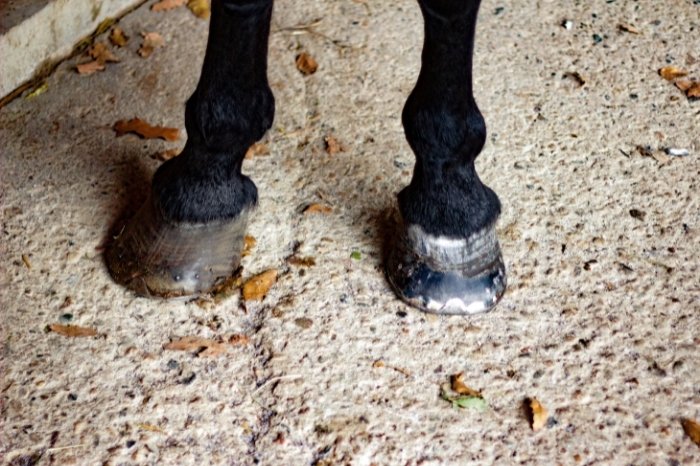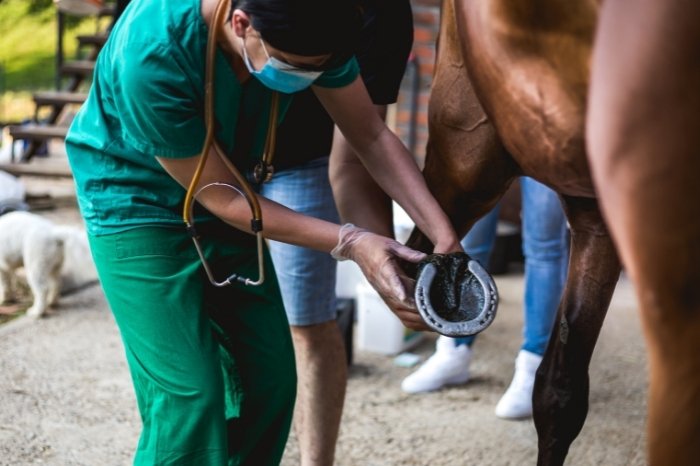Last Updated on July 19, 2022
The occasional horse stumbling hind end isn’t generally something to worry about. However, if your horse begins stumbling regularly, this could potentially be a serious issue. There are many factors that cause stumbling, so it is important to pinpoint the issue and correct it.
It can be as simple as your horse needs a hoof trimming or something more complex like a neurological issue. A veterinarian, farrier, or trainer can generally help correct hind end stumbling in a horse. Though every horse stumbles from time to time, regular stumbling of the hind end is not normal.
Horse Stumbling Hind End: Causes Of Stumbling
If your horse stumbles on their hind end every once in a while, it is generally something to worry about. However, if your horse is regularly stumbling, it is a sign that something is off. This could be something minor like your horse is tired because he is out of shape, or something more serious like equine protozoal myeloencephalitis.
Hoof Problems
One of the most common causes of stumbling in horses is hoof problems. Long toes is the most common problem for this issue, but there are also other hoof problems that can cause stumbling.

It is not uncommon for horses with long toes to stumble when they are working. In some cases, long toes can be an issue horses are predisposed to, or in other cases, it can be from inadequate shoeing or too much time between trims.
Check Out How Much Do Equine Vets Make?
Downhill Build
Sometimes, horses may be prone to stumbling due to their conformation. A horse with a downhill build has hindquarters that are higher than his withers, resulting in the horse carrying extra weight on his forehand. Due to this conformation flaw, a horse may be more prone to tripping.
Unbalanced
Balance is important when riding. If a horse is unbalanced when performing different gaits, it can result in stumbling as the horse comes strung out.
The Rider – Horse Stumbling Hind End
When riders are not properly paired with a horse that accommodates their size and fitness level, it can potentially cause problems for the horse. If a rider is too heavy for the horse and unbalanced, it can cause discomfort and make the horse unbalanced.
Fitness
If a horse is unfit or is being pushed past his fitness level, he may struggle. When horses become tired, they may become lazier about picking up their feet, resulting in tripping.
Purina Carb Conscious Horse Treats, 5 lb
Uneven Or Slippery Footing
A common and simple reason why a horse slip is uneven or slippery footing. Some horses are simply more sure-footed than others.
Saddle Fit
An ill-fitting saddle can cause all sorts of problems for a horse. If the saddle does not fit right, it can cause back pain in a horse and lead to stumbling.
Pain – Horse Stumbling Hind End
If your horse is in pain, it can result in stumbling. There are several factors that could cause a horse pain that then leads to stumbling. The pain can be a result of an unhealed injury, arthritis, Navicular Syndrome, Sweeney, laminitis or ring bone or side bones, among other things.
Neurological Issues
One of the most serious causes of hind stumbling in horses is neurological issues. Neurological issues can happen because of various reasons including Equine Protozoal Myeloencephalitis (EPM) or Lyme disease.
What To Do If Your Horse Is Stumbling
If your horse is stumbling on a regular basis, you will want to seek the help of a professional. Depending on what is causing the stumbling, that will be a veterinarian, farrier, or trainer.
Use A Proper Fitting Saddle
Be sure to make sure that your saddle properly fits your horse so that it doesn’t cause any back problems. A professional saddle fitter and trainer can help you find a saddle that properly fits you and your horse.
Improve Your Horse’s Fitness And Balance
If your horse is healthy, has good feet, and has a properly fitting saddle, you will want to improve their fitness and make sure they are balanced when you ride. In addition, you will want to make sure that you are balanced and that your horse can safely support your size.
Talk With Your Farrier – Horse Stumbling Hind End
If you suspect your horse’s stumbling problems are hoof related, talk with your farrier. Your farrier can help correct the angle of your horse’s hooves to prevent stumbling. In addition, be sure that you are getting your horse’s hooves trimmed approximately every six weeks.
Talk With Your Veterinarian
If your horse regularly stumbles, throws you off balance during a stumble, has joint swelling or appears weak, it is time to call a veterinarian. In addition, if your horse is exhibiting signs of incoordination or neurological weakness, such as having issues turning in a small circle, you will want to let your veterinarian know. Your veterinarian can examine your horse to determine what is causing the stumbling and then properly treat your horse from there.

Stumbling Hind End In Horses
Occasional stumbling in horses is normal, but when it becomes more common it should be looked into as it can be something more serious. You should discuss the matter with your veterinarian, farrier and trainer.
Do you have any questions regarding the problem of a horse stumbling hind end? If so, please ask your questions as to why horses stumble in the comments.

